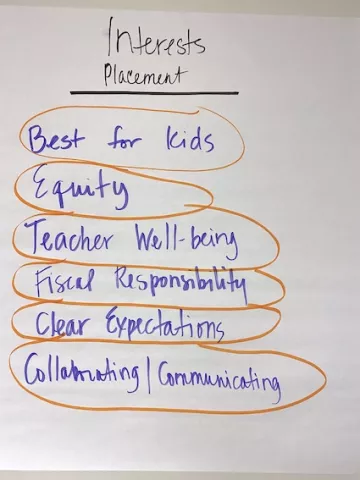Key Takeaways
- The Clawson Education Association is the first to restore all of its contract rights since anti-worker laws were overturned in Michigan. The results are life-changing for its members, and inspiring to other educators in the state.
- Years of educator advocacy with state legislators and work to elect pro-public schools candidates paid off with the overturn of anti-worker laws that targeted educators.
- The Clawson wins can serve as inspiration to other locals in Michigan, and to other states looking to establish pro-worker policies.
In her nearly 14 years as president of the Clawson Education Association, in Clawson, Mich., Kelly Pearson has not bargained a better contract than the one she recently signed. Overwhelmingly approved by membership, the deal struck different responses between early-career and longer-term educators.
“[F]or those veterans who remember what it was like before, all of a sudden they’re like, ‘It’s back the way it used to be.’ Whereas the newer people are saying, ‘This is a whole new world,’” said Pearson.
It wasn’t just the deal’s strong financial gains that drew smiles and sustained applause at the end of the 90-minute meeting to review the tentative agreement, she said: “People are excited about what we got back in the restored topics.”
With a contract expiring in December of 2023, the Clawson unit was among the first in the state to begin negotiating over important topics that had been barred from tables for a dozen years or more by politicians who sought to weaken unions’ collective bargaining strength.
Thanks in part to Michigan Education Association (MEA) advocacy, last year a new legislature joined with Gov. Gretchen Whitmer to restore the rights of educators, whose voices had been silenced around several subjects they had previously bargained for decades – relating to evaluation, placement, layoff and recall, and discipline and discharge.
Other changes passed last year eliminated one-sided penalties against educators when contracts expired without a successor agreement in place – thereby balancing what had been unequal power granted to school districts – and returned the ability of locals to choose payroll deduction for union dues.
Educator Advocacy Pays Off

“Honestly what the state legislature did was amazing,” said Pearson, a first-grade teacher and 25-year classroom veteran. “Take just one example: evaluation.”
Championed by former MEA-member educators in the House and Senate who now chair Education Committees in their respective chambers – Sen. Dayna Polehanki and Rep. Matt Koleszar – the new evaluation law removes state standardized test scores from teacher ratings beginning next school year.
Educators had doggedly advocated for years for fixes to problems of fairness and accuracy in the teacher evaluation system overhauled by Republican lawmakers and Gov. Rick Snyder in 2011.
Part of larger efforts to make it easier to fire teachers, the evaluation system designed in 2011 discouraged collaboration, downgraded those working with the neediest students, ratcheted up the importance of standardized test scores, and sought to penalize rather than develop educators.
“It was a bad system, and I’m so glad the Legislature was able to do what they did,” Pearson said.
Among other evaluation changes passed last year, student growth lowers from 40 to 20 percent of an educator’s score; meaningful measurements of student performance are determined locally; a process returns for challenging unfair ratings; and educators deemed effective can move to triennial evaluations.
While keeping state-approved evaluation tools required since 2015, the new law allows bargainers to adapt the tools to meet local needs. In Clawson, that will happen through a committee forming as part of the contract settlement. Made up of equal numbers from administration and teaching ranks, the committee will look at potential modifications to make the tool more appropriate and less cumbersome.
Making Bargaining Collaborative
Key to settling the large number of open issues in the contract, including salary and benefits in addition to the newly restored topics, was the negotiation method used to bring the two sides together, according to Director Chris Pratt, the MEA staffer who assisted the Clawson team.

Both sides agreed to undertake Interest-Based Bargaining (IBB), a model that encourages collaboration through a formal process for advancing facts and perspectives, listening, developing shared interests, and brainstorming to seek common ground, Pratt said.
“It’s beneficial to build a culture where administrators and teachers listen to each other. They may not agree, but to listen and understand where the other party is coming from really does help.”
Pearson agreed IBB was key to success – though not easy or fast; the bargain took 88 hours “In IBB, instead of the traditional approach where you pass proposals back and forth across the table, you work together collectively as a team,” she said. “We even mixed up where we sat.”
Bargainers completed a two-day training to build trust and learn the process. Determining shared values and listening to each other on each topic helped the group work through dozens of ideas – amid real struggles – to find agreement on all restored subjects.
“You saw teachers having meaningful conversation over these very important subjects for the first time in over a decade,” Pratt said, “and the result is a small bargaining unit of about 100 teachers figured it out and will hopefully end up being a lighthouse district.”
However, not every district has a leader interested in working collaboratively, which makes it important for local unions to organize and build solidarity so they can present a strong message and unified front at the table, said Craig Culver, MEA’s Statewide Bargaining Consultant.
“Teachers were once singled out from other employee groups to have their employment rights removed by law, but they no longer have to be second-class citizens,” Culver said. “Next comes the need for an organized membership to help support what will be an extra heavy lift in districts resistant to restoring basic workplace rights for teachers.”
A New Day for Clawson Teachers
Pearson was among several leaders from MEA locals who spoke before the House Labor Committee last spring as the bills to restore educator bargaining rights were debated in the legislature.
In her testimony, Pearson told of a teacher in her unit whose job assignment changed involuntarily nine times in eight years – once shifting her from middle school to developmental kindergarten – a practice unfair to both educators and students but which the union was not allowed to address.
With those bills signed into law, the Clawson bargainers established staff placement rules which limit involuntary placements of tenured teachers to once every five years.
“We got back almost all of the language we had before they took away our right to bargain placement, so what happened to that poor teacher – moving nine times in eight years – couldn’t happen now,” Pearson said. “As it should be.”
“With everything we’ve been able to get back, I feel like we’ll be able to recruit the next generation of young people. We’re rounding the corner.”
Despite bumps in the road, the deal forged in Clawson also re-established “just cause” as the rightful standard for disciplining a teacher instead of the extremely low bar of “not arbitrary and capricious,” which has empowered school districts to more aggressively target and discipline or discharge teachers.
For the first time the contract adds procedures for progressive discipline. Now everyone – administrators and staff alike – understands the steps and progression of repeated discipline, and coaching gives individuals opportunity to improve.
The bargainers met in the middle on layoff and recall rules. Now, each teacher’s evaluation rating is considered first instead of individual number scores. If those are equal, then seniority is used next.
The deal also restores payroll deduction for union dues next fall, which simplifies and splits the amount over two pay periods.
The team saved the financial discussion for last but certainly not least, Pearson added. The final deal continues an effort begun in the previous contract to beef up the salary schedule and restore steps for those who were frozen and took a pay cut during hard times.
Everyone will see at least a 3 percent increase on base salary, significantly higher longevity bonuses beginning at five years, added days for bereavement, class size reductions, and more.
Moving forward
When agreement couldn’t be reached on raises or steps in the third year, the union agreed only to a two-year contract. That choice was made possible by repeal of a union-busting rule passed in 2011 which penalized only one side financially – educators – when negotiations reached an impasse.
“Now if we don’t have a settled contract come December 31, 2025, everyone on steps will move up one at least,” Pearson said. “That wasn’t the case for a while.”
The longtime leader applauded the CEA bargaining team, comprised of a balanced group of veteran, mid-career and newer educators for working together to benefit all, including students and the community.
"I’m happy my last contract as president was the best one,” Pearson said. "With everything we’ve been able to get back, I feel like we’ll be able to recruit the next generation of young people. We’re rounding the corner.”


